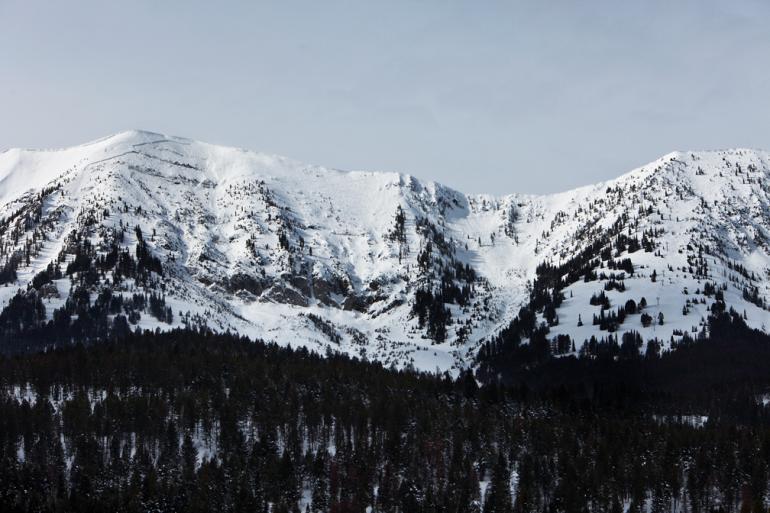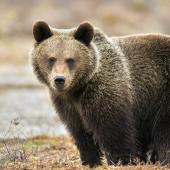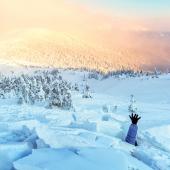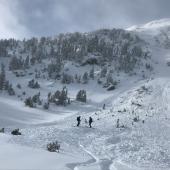The Saddle Peak Avalanche
Many folks believe that we can ski Saddle “safely.” How can we safely ski any slope with people hidden below and out of view while others are dropping in on top of you? It would be more accurate to say we ski Saddle “luckily.”
The 2009 season began with ample snowfall in October and November in the Bridger Mountains, and a storm on November 12 pummeled downtown Bozeman with more than 20 inches. By December, the great moisture spigot in the sky ran dry and the bottom fell out of the thermometer. Deep-freeze temperatures had a stranglehold on the mountains, and the snowpack turned into weak, faceted depth hoar. Big winds deposited a very hard slab over this weak layer. The layer was our nemesis for the entire season—a hidden enemy that Doug Chabot, Director of the Gallatin National Forest Avalanche Center would call, “the layer we will be talking about when Saddle Peak slides this year.”
The Big Slide
He couldn’t have been more accurate. In January, heavy snowfall produced the worst avalanche cycle in 20 years, according to Chabot. The Avalanche Center was receiving reports of human-triggered and natural avalanche activity like Morse code coming over the wire.
Valentine's Day is for lovers, and February 14 brought powder lovers the biggest dump of the year. The skiing at Bridger was amazing, but astute skiers noticed something weird: low-angle and flat terrain was collapsing and cracking with a short WHOOOMPF noise. It was a massive loading event that the underlying weak layers were straining to support. The ski patrol was busy with avalanche control work in-bounds, but throngs of powder-starved skiers were headed to Saddle Peak, just past the ropes. In a short period of time hundreds of tracks graced the Football Field, the Shoulder, and the ski shots further south.
On the windy but beautiful morning of February 16, people left the top of the Schlasman’s lift, booting their way toward the summit of Saddle Peak. At 11am, a person on a cornice near the summit knocked a van-sized block of snow down the slope. The weight of the rolling cornice caused the buried weak layer to collapse, and the fracture propagated across the slope. The resulting avalanche broke three to six feet deep, was more than 1,000 feet wide, and ran 2,000 vertical feet, coming to rest below the Schlasman base area. The powder cloud was visible at Bridger Bowl, and skiers on the lifts even caught it on film.
When the slide came to rest, skiers on adjacent slopes immediately began rescue efforts, but unbelievably, no one was caught in the avalanche. Given the amount of traffic on Saddle Peak during previous days, the level of good fortune was staggering.
In the Bull's-Eye
Later, over 200 people attended a forum the Gallatin National Forest Avalanche Center hosted at the Bozeman Public Library. An informal survey of the skiers leaving Bridger to hike Saddle Peak was conducted after the forum. The results were sobering: of those surveyed, 20% had no shovel, 34% had no probe, and 9% were skiing solo. Sadly, none of the people hiking to Saddle Peak on the days the survey was conducted had attended the public forum.
It's clear that several misconceptions surrounding sidecountry and backcountry terrain still exist. Perhaps the most common is that ski tracks on a slope mean it is stable. This is simply not true, though we often hear people referring to “skier compaction” as a way to stabilize a slope. The weak layer in the Saddle Peak avalanche was protected by a very hard slab above it, on which people skied. The buried weak layer was unaffected by skier compaction, and so it lingered, waiting for just the right trigger. Solid side-country and backcountry skiers make a habit of following the weather and snowpack very carefully, and they do not decide to ski a slope just because others have already chosen to ski the line.
The best thing skiers can do is take an objective look at how they decide to ski any sidecountry or backcountry slope. Instead of relying on outlier information such as ski tracks, familiarity with the terrain, or seeing others skiing without incident, rely on the simple facts. How much did it snow? What were the winds doing? Were there obvious signs of instability? Was there a buried weak layer? We call this “bull's-eye” data.
Here is the “bull's-eye” data for the Saddle Peak avalanche. A huge storm ended just 36 hours before the slide. Strong wind loading added additional stress to a well-known and very persistent weak layer. Mother Nature dropped a hint with large natural and human-triggered avalanches nearby. And all of this information was available on the avalanche advisory the morning of the slide.
Although this slide was big, it can—and will—go bigger. Back in 1980 it went wall to wall. The whole face that is visible from the road slid, including the Football Field. When this happens, what are the chances of us being so lucky again?
We started the 2010-11 season with a nice big dump in October. The next several weeks set the stage for the whole season. What did we learn?
Jay Pape is the education coordinator for the Friends of the Gallatin National Forest Avalanche Center. Last winter, there were 87 reported avalanche incidents in the areas covered by The Avalanche Center. Twenty-one people were caught in avalanches; nine were partially buried, three were completely buried, and three died. During the entire 2009-10 season, the avalanche danger was never rated LOW.












